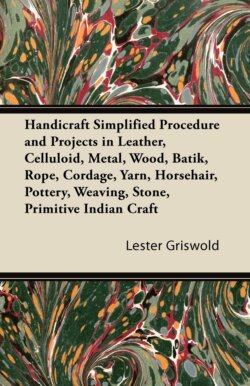Читать книгу Handicraft Simplified Procedure and Projects in Leather, Celluloid, Metal, Wood, Batik, Rope, Cordage, Yarn, Horsehair, Pottery, Weaving, Stone, Primitive Indian Craft - Lester Griswold - Страница 49
На сайте Литреса книга снята с продажи.
ASSEMBLY PROCEDURE Edge Lacing
Оглавление
The photographic illustration shows corner lacings, using both wide and narrow thongs. The thong is passed through the corner hole twice or three times as may be necessary to make the laced edge have a smooth appearance.
Sketches B and C, Fig. 5, show the method of perforating the leather for edge lacing, using an awl instead of the punch with the hole spacing gauge. A greater strength is obtained between perforations by placing the awl in the position shown in Sketch B. The hole spacing may be first marked with the dividers as indicated. The holes are punched as the lacing progresses and it may be necessary to spread them with a marlin spike or the end of the tracing tool to receive the end of the lace. Sketches D and E, Fig. 6, show another method of perforating the leather for edge lacing, using the thong chisel. The chisels are available with one, three, and four prongs as indicated by Sketches A, B, and C. The single prong chisel is useful for punching corner holes or slits. The three or four prong chisels are used as indicated in Sketches D and E. The hole spacing is controled by placing one prong of the chisel in the last hole punched. Sketch F shows a Thong Lacing Tip or needle which facilitates lacing through the awl or chisel cut perforations. This metal tip is made like a clothes pin. The end of the leather lacing is held between two thin pieces of metal which are soldered together at one end.
Fig. 5
Fig. 6
With any of the foregoing types of edge lacing the following principles must be observed to insure neat appearing work. Keep the margin between holes and edge exact by following carefully the creased line as shown in Fig. 5 above, as a guide in punching. Do not permit the thong to get twisted. This may be prevented by running the thumb and forefinger back from the edge of the leather to the point of the thong end before inserting it for the next stitch. Do not try to work with too long a thong. A two yard length is as long as may be easily handled, and if care is taken in splicing as described, the ends will not be noticeable. More important is the caution against pulling the lacing too tight. Sketch C, Fig. 4, page 68, shows how to pull up the first loop of the single layover before tightening the second. The finished lacing should lie along the edge as shown in Sketch E, and not be pulled to either side, or pucker the edges of the leather. In finishing the lacing the end may be concealed by trimming to a narrow long point and then running it back under the lacing several stitches. This will be easily done if the last three or four stitches are left loose and then tightened by pulling up carefully the separate loops, after the end has been run back. The final step in the process is to flatten the lacing by pounding with a smooth wooden mallet, see illustration, page 67.
